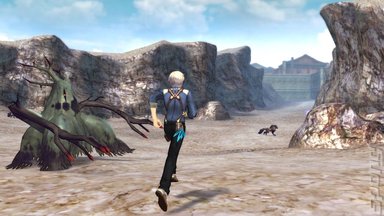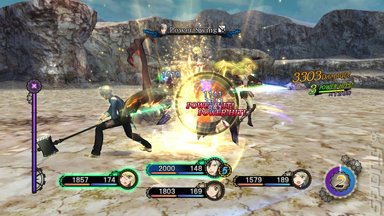I'm almost entirely certain that in Game Design 101's early chapters it states that opening your game with an hour long slog through identical corridors is a big no-no. I also have it on good authority (common sense) you don't then stick the player with a debt of twenty-million in whatever your game uses for currency.
Welcome to Tales of Xillia 2, a direct sequel to one of the better Tales games released in the series. As you can no doubt tell from these opening comments, I haven't been too pleased with the game. You take the role of Ludger Kressnik, who doesn't really talk in the game aside of the occasional 'yeah' and uncomfortable grunts. This is in sharp contrast to the fully-voiced protagonists from Xillia 1's Jude and Milla, both of whom are present again in Xillia 2, and fully-voiced throughout the main campaign. Jude, for the most part, is the primary voice of the game, pushing us along the narrative as we marvel at Ludger's array of reactions... Oh, wait his reactions are restricted to 'shocked', 'dismayed', 'nonplussed', and 'content', which can be indistinguishable because of lazy facial animations.
So Ludger is our point-of-view character; a vessel through which we witness the game's narrative. Let's move on to something far more positive - the returning cast from the first game. Everyone is back and they have all changed in some way. Providing you developed attachments to these characters first time around, you'll get a kick out of hearing what they've been up to. [Beware - sensitive types may consider the following details "spoilers". Skip this paragraph is that be you.] Alvin, the double-crossing rogue is now a fruit merchant. Rowan is, once again, advisor to royalty. Elize has transformed from a shy little girl into a slightly less young, more sociably capable young woman. It's a shame that the new characters don't feel as fleshed out. Some of them feel far too similar to existing characters - characters such as Nova, your loan officer/friend from school, who felt like a slightly retooled version of Leia. In fact, at first I thought she was Leia until Leia showed up and proved to be a bumbling junior reporter.
Disclaimer time - I haven't finished the game at time of writing, nor am I likely to in the near future. Every time I think about this game I get frustrated because in my heart I know that the story will end up being worth it - just like it was in the original game. But then I remember that I have to grind endlessly to unlock to next chapter of the main story. Grinding levels to become strong enough to beat a troublesome boss is something I enjoy in RPGs. It gives you a sense of your character's growth when you go back to a boss that murdered your party, then proceed to beat it senseless. That is how grinding should work. In Tales of Xillia 2, however, you have the single most stupid mechanic in RPG game design in recent history - the loan I mentioned at the start of this review. When injured, the whopping bill from an unscrupulous organisation providing medical care can come to millions in gald (read gold). This would be okay if it was something paid off through side quests, which perhaps led to rewards and potentially an extended ending. But sadly, it doesn't work like that. Instead you have to grind for gald/gold by doing tedious "fetch" and "monster killing" quests to make a payment, and until you do make that payment the game's critical path is closed off to you. During these down times you can pursue individual character story quests to learn more about your companions, but all sense of tension and approaching dread is sapped out of the story through artificial gating.
In the original game there were a ton of fun mechanics for levelling various aspects, such as gaining new items by improving the vendors in place of direct crafting, and being able to customise each character's build by choosing where to go in a Lirium orb. The vendor levelling has been removed and replaced with a custom ordering system - you hand over certain arbitrary items in exchange for special gear. The orb for levelling has undergone a name change and been simplified - you have different orbs, each one corresponds to an element and as you level you move down a fixed track of new Artes and abilities. These aren't necessarily bad changes, but they aren't improvements either.
And therein lies the games' problem; outside of the jarring loan mechanic the game doesn't feel like a step forward like a good sequel should be. Instead we have side steps that change things up, but feel forced in the process. Will I eventually finish this game? Maybe. Has it put me off future 'Tales of' game? Absolutely not. But I may skip them until we get a current-gen title.
Pros
+ Brilliant combat system, familiar to Tales fans.
+ Nice to see returning characters and how they've changed.
Cons
- That horrid 20 million gald loan!
- Protagonist might as well be silent.
- Lacklustre environmental design.
SPOnG Score - 2/5
Welcome to Tales of Xillia 2, a direct sequel to one of the better Tales games released in the series. As you can no doubt tell from these opening comments, I haven't been too pleased with the game. You take the role of Ludger Kressnik, who doesn't really talk in the game aside of the occasional 'yeah' and uncomfortable grunts. This is in sharp contrast to the fully-voiced protagonists from Xillia 1's Jude and Milla, both of whom are present again in Xillia 2, and fully-voiced throughout the main campaign. Jude, for the most part, is the primary voice of the game, pushing us along the narrative as we marvel at Ludger's array of reactions... Oh, wait his reactions are restricted to 'shocked', 'dismayed', 'nonplussed', and 'content', which can be indistinguishable because of lazy facial animations.
So Ludger is our point-of-view character; a vessel through which we witness the game's narrative. Let's move on to something far more positive - the returning cast from the first game. Everyone is back and they have all changed in some way. Providing you developed attachments to these characters first time around, you'll get a kick out of hearing what they've been up to. [Beware - sensitive types may consider the following details "spoilers". Skip this paragraph is that be you.] Alvin, the double-crossing rogue is now a fruit merchant. Rowan is, once again, advisor to royalty. Elize has transformed from a shy little girl into a slightly less young, more sociably capable young woman. It's a shame that the new characters don't feel as fleshed out. Some of them feel far too similar to existing characters - characters such as Nova, your loan officer/friend from school, who felt like a slightly retooled version of Leia. In fact, at first I thought she was Leia until Leia showed up and proved to be a bumbling junior reporter.
Disclaimer time - I haven't finished the game at time of writing, nor am I likely to in the near future. Every time I think about this game I get frustrated because in my heart I know that the story will end up being worth it - just like it was in the original game. But then I remember that I have to grind endlessly to unlock to next chapter of the main story. Grinding levels to become strong enough to beat a troublesome boss is something I enjoy in RPGs. It gives you a sense of your character's growth when you go back to a boss that murdered your party, then proceed to beat it senseless. That is how grinding should work. In Tales of Xillia 2, however, you have the single most stupid mechanic in RPG game design in recent history - the loan I mentioned at the start of this review. When injured, the whopping bill from an unscrupulous organisation providing medical care can come to millions in gald (read gold). This would be okay if it was something paid off through side quests, which perhaps led to rewards and potentially an extended ending. But sadly, it doesn't work like that. Instead you have to grind for gald/gold by doing tedious "fetch" and "monster killing" quests to make a payment, and until you do make that payment the game's critical path is closed off to you. During these down times you can pursue individual character story quests to learn more about your companions, but all sense of tension and approaching dread is sapped out of the story through artificial gating.
In the original game there were a ton of fun mechanics for levelling various aspects, such as gaining new items by improving the vendors in place of direct crafting, and being able to customise each character's build by choosing where to go in a Lirium orb. The vendor levelling has been removed and replaced with a custom ordering system - you hand over certain arbitrary items in exchange for special gear. The orb for levelling has undergone a name change and been simplified - you have different orbs, each one corresponds to an element and as you level you move down a fixed track of new Artes and abilities. These aren't necessarily bad changes, but they aren't improvements either.
And therein lies the games' problem; outside of the jarring loan mechanic the game doesn't feel like a step forward like a good sequel should be. Instead we have side steps that change things up, but feel forced in the process. Will I eventually finish this game? Maybe. Has it put me off future 'Tales of' game? Absolutely not. But I may skip them until we get a current-gen title.
Pros
+ Brilliant combat system, familiar to Tales fans.
+ Nice to see returning characters and how they've changed.
Cons
- That horrid 20 million gald loan!
- Protagonist might as well be silent.
- Lacklustre environmental design.
SPOnG Score - 2/5




